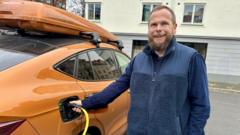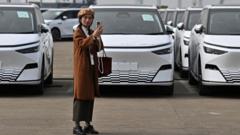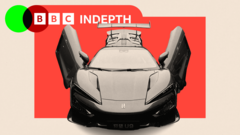Norway is on the brink of becoming the first country to cease the sale of new fossil-fuel cars, as electric vehicles dominate the automotive landscape.
Norway Sets the Standard for Electric Vehicle Adoption

Norway Sets the Standard for Electric Vehicle Adoption
Norway leads global electric vehicle sales, with major implications for international auto markets.
Norway has taken the lead in electric vehicle (EV) adoption globally, with an impressive 88.9% of new car sales in the country last year being electric. This shift marks a significant milestone for the Nordic nation, aiming for all new vehicle sales to be "zero emission" as early as 2025. Car dealerships, such as the Oslo-based Harald A Møller, have entirely transitioned to selling electric models, highlighting the country’s commitment to promoting sustainable transport.
A thriving populace of 5.5 million has made substantial strides in reducing emissions, with electric cars now outnumbering petrol-powered ones on the roads. This surge in adoption results from a combination of aggressive tax incentives for EV purchases and environmental policies that discourage the use of fossil fuel vehicles.
Norway's electric vehicle journey began in the early 1990s, when the government started imposing higher taxes on conventional petrol and diesel cars while exempting electric vehicles from such fees. Over the years, this strategy has attracted consumers to EVs, making them a financially appealing choice.
Regions of Oslo now showcase a prevalence of electric cars, often indicated by a distinctive "E" on their license plates. The nation boasts an extensive network of charging stations, ensuring that the transition to electric is seamless for its drivers. More than 27,000 public chargers are accessible across Norway, which translates to 447 stations per 100,000 people—significantly higher than countries like the UK, which has only 89 per 100,000 residents.
It’s worth noting that while Norway is a significant oil producer, the government has strategically maintained a favorable environment for EV adoption, thus rendering fossil-fuel options relatively unattractive to consumers. With a wealthy population and ample renewable resources, Norway exemplifies how long-term policies and infrastructure support can effectively drive change in transportation modalities worldwide.
As Norway approaches its ambitious electric vehicle goals, officials emphasize that their approach can serve as a blueprint for other countries. They encourage tailored strategies that consider unique market conditions rather than direct imitation. The transformative journey of Norway’s automotive sector signifies a potential paradigm shift towards sustainable, electric transport that could inspire global measures against climate change.
A thriving populace of 5.5 million has made substantial strides in reducing emissions, with electric cars now outnumbering petrol-powered ones on the roads. This surge in adoption results from a combination of aggressive tax incentives for EV purchases and environmental policies that discourage the use of fossil fuel vehicles.
Norway's electric vehicle journey began in the early 1990s, when the government started imposing higher taxes on conventional petrol and diesel cars while exempting electric vehicles from such fees. Over the years, this strategy has attracted consumers to EVs, making them a financially appealing choice.
Regions of Oslo now showcase a prevalence of electric cars, often indicated by a distinctive "E" on their license plates. The nation boasts an extensive network of charging stations, ensuring that the transition to electric is seamless for its drivers. More than 27,000 public chargers are accessible across Norway, which translates to 447 stations per 100,000 people—significantly higher than countries like the UK, which has only 89 per 100,000 residents.
It’s worth noting that while Norway is a significant oil producer, the government has strategically maintained a favorable environment for EV adoption, thus rendering fossil-fuel options relatively unattractive to consumers. With a wealthy population and ample renewable resources, Norway exemplifies how long-term policies and infrastructure support can effectively drive change in transportation modalities worldwide.
As Norway approaches its ambitious electric vehicle goals, officials emphasize that their approach can serve as a blueprint for other countries. They encourage tailored strategies that consider unique market conditions rather than direct imitation. The transformative journey of Norway’s automotive sector signifies a potential paradigm shift towards sustainable, electric transport that could inspire global measures against climate change.

















